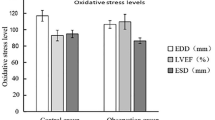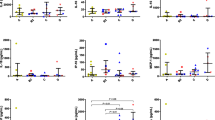Abstract
The aim of study was to determine the effects of ozone therapy on the oxidative stress, cardiac functions and clinical findings in patients with heart failure reduced ejection fraction (HFrEF). A total of 40 patients with New York Heart Association 2 and 3 HF with left ventricular ejection fraction (LVEF) <35%, and 40 subjects without HF as control group were included in the study. Patients with HFrEF were given additional ozone therapy of major and minor administrations along with conventional HF treatment for 5 weeks. Before and after ozone therapy, left ventricular end-systolic and end-diastolic volumes (LVESV, LVEDV) and the 6 minute walk distance (6MWD) and blood levels of the superoxide dismutase (SOD), catalase (CAT), glutathione (GSH), glutathione peroxidase (GSHPx), malondialdehyde (MDA), nitric oxide (NO) and N-terminal pro-brain natriuretic peptide (NT-proBNP) were measured. Ozone therapy significantly reduced the serum levels of NO and MDA (p < 0.001, respectively) and significantly increased the levels of SOD, CAT, GSH and GSHPx (p < 0.001, respectively). LVEDV and LVESV were found to be significantly reduced; however, LVEF was not found to be significantly increased (p = 0.567). As the biochemical improvement marker of HF, NT-proBNP was significantly reduced (p < 0.001). The clinical HF improvement marker of 6 minute walk distance was also modestly increased (p < 0.001). Ozone therapy might be beneficial in terms of activating antioxidant system and merit further therapeutic potential to conventional HF treatment in patients with HFrEF.
Similar content being viewed by others
References
Sawyer, D. B. (2011). Oxidative stress in heart failure: what are we missing? The American Journal of the Medical Sciences, 342, 120–124.
Amir, O., Paz, H., Rogowski, O., Barshai, M., Sagiv, M., Shnizer, S., et al. (2009). Serum oxidative stress level correlates with clinical parameters in chronic systolic heart failure patients. Clinical Cardiology, 32, 199–203.
Nain, S., Wojnarowicz, C., Laarveld, B., & Olkowski, A. A. (2008). Effects of dietary vitamin E and C supplementation on heart failure in fast growing commercial broiler chickens. British Poultry Science, 49, 697–704.
Bocci, V. (2006). Scientific and medical aspects of ozone therapy state of the art. Archives of Medical Research, 37, 425–435.
Stübinger, S., Sader, R., & Filippi, A. (2006). The use of ozone in dentistry and maxillofacial surgery: a review. Quintessence International, 37, 353–359.
Nogales, C. G., Ferrari, P. H., Kantorovich, E. O., & Lage-Marques, J. L. (2008). Ozone therapy in medicine and dentistry. The Journal of Contemporary Dental Practice, 9, 75–84.
Martínez-Sánchez, G., Al-Dalain, S. M., Menéndez, S., Re, L., Giuliani, A., Candelario-Jalil, E., et al. (2005). Therapeutic efficacy of ozone in patients with diabetic foot. European Journal of Pharmacology, 523, 151–161.
Di Paolo, N., Gaggiotti, E., & Galli, F. (2005). Extracorporeal blood oxygenation and ozonation: clinical and biological implications of ozone therapy. Redox Report, 10, 121–130.
The International Scientific Committee of Ozone Therapy, “Madrid declaration on ozone therapy,” http://www.aepromo.org/declaracion madrid/Madrid declaration.pdf.
Bocci, V., & Oxygen-ozone therapy. (2002). A critical evaluation (pp. 1–427). Dordrecht, The Netherlands: Kluwer Academic Publishers.
Bocci, V. A., Zanardi, I., & Travagli, V. (2011). Ozone acting on human blood yields a hormetic dose-response relationship. Journal of Translational Medicine, 17, 66.
Bocci, V., Zanardi, I., Huijberts, M. S., & Travagli, V. (2011). Diabetes and chronic oxidative stress. A perspective based on the possible usefulness of ozone therapy. Diabetes and Metabolic Syndrome, 5(1), 45–49.
Placer, Z. A., Chusman, L., & Johnson, B. C. (1966). Estimation of products of lipid peroxidation in biological fluids. Analytical Biochemistry, 16, 359–364.
Lawrence, R. A., & Burk, R. F. (1976). Glutathione peroxidase activity in selenium-deficient rat liver. Biochemical and Biophysical Research Communications, 71, 952–958.
Sun, Y., Larry, W. O., & Ying, L. (1988). A simple method for clinical assay of superoxide dismutase. Clinical Chemistry, 34, 497–500.
Sedlak, J., & Lindsay, R. H. C. (1968). Estimation of total, protein-bound, and nonprotein sulfhydryl groups in tissue with Ellman’s reagent. Analytical Biochemistry, 25, 192–205.
Aebi, H. E. (1987). Catalase. In H. U. Bergmeyer (Ed.), Methods of enzymatic analysis (3rd ed., pp. 273–286). Florida: Verlag Chemie, Weinheim.
Schiller, N. B., Shah, P. M., Crawford, M., DeMaria, A., Devereux, R., Feigenbaum, H., et al. (1989). Recommendations for quantitation of the left ventricle by two-dimensional echocardiography. American Society of Echocardiography Committee on Standards, Subcommittee on Quantitation of Two Dimensional Echocardiograms. Journal of the American Society of Echocardiography, 2, 358–367.
ATS Committee on Proficiency Standards for Clinical Pulmonary Function Laboratories. (2002). ATS statement: guidelines for the six-minute walk test. American Journal of Respiratory and Critical Care Medicine, 166, 111–117.
Pimentel, D. R., Amin, J. K., Xiao, L., Miller, T., Viereck, J., Oliver-Krasinski, J., et al. (2001). Reactive oxygen species mediate amplitude-dependent hypertrophic and apoptotic responses to mechanical stretch in cardiac myocytes. Circulation Research, 89, 453–460.
Arstall, M. A., Sawyer, D. B., Fukazawa, R., & Kelly, R. A. (1999). Cytokine-mediated apoptosis in cardiac myocytes: the role of inducible nitric oxide synthase induction and peroxynitrite generation. Circulation Research, 85, 829–840.
Hill, M. F., & Singal, P. K. (1996). Antioxidant and oxidative stress changes during heart failure subsequent to myocardial infarction in rats. American Journal of Pathology, 148, 291–300.
Hill, M. F., & Singal, P. K. (1997). Right and left myocardial antioxidant responses during heart failure subsequent to myocardial infarction. Circulation, 96, 2414–2420.
Belch, J. J., Bridges, A. B., Scott, N., & Chopra, M. (1991). Oxygen free radicals and congestive heart failure. British Heart Journal, 65, 245–248.
Arai, M., Alpert, N. R., MacLennan, D. H., Barton, P., & Periasamy, M. (1993). Alterations in sarcoplasmic reticulum gene expression in human heart failure. A possible mechanism for alterations in systolic and diastolic properties of the failing myocardium. Circulation Research, 72, 463–469.
Bocci, V. (1996). Does ozone therapy normalize the cellular redox balance? Implications for therapy of human immunodeficiency virus infection and several other diseases. Medical Hypotheses, 46(2), 150–154.
Borrego, A., Zamora, Z. B., González, R., Romay, C., Menéndez, S., Hernández, F., et al. (2004). Protection by ozone preconditioning is mediated by the antioxidant system in cisplatin-induced nephrotoxicity in rats. Mediators of Inflammation, 1, 13–19.
Safwat, M. H., El-Sawalhi, M. M., Mausouf, M. N., & Shaheen, A. A. (2014). Ozone ameliorates age-related oxidative stress changes in rat liver and kidney: Effects of pre- and post-ageing administration. Biochemistry, 5, 450–458.
Borrelli, E., Diadori, A., Zalaffi, A., & Bocci, V. (2012). Effects of major ozonated autohemotherapy in the treatment of dry age related macular degeneration: a randomized controlled clinical study. International Journal of Ophthalmology, 5(6), 708–713.
Wu, X. N., Zhang, T., Wang, J., Liu, X. Y., Li, Z. S., Xiang, W., et al. (2016). Magnetic resonance diffusion tensor imaging following major ozonated autohemotherapy for treatment of acute cerebral infarction. Neural Regeneration Research, 11(7), 1115–1121.
Ghatak, A., Brar, M. J., Agarwal, A., Goel, N., Rastogi, A. K., Vaish, A. K., et al. (1996). Oxy free radical system in heart failure and therapeutic role of oral vitamin E. International Journal of Cardiology, 57, 119–127.
Keith, M. E., Jeejeebhoy, K. N., Langer, A., Kurian, R., Barr, A., O’Kelly, B., et al. (2001). A controlled clinical trial of vitamin E supplementation in patients with congestive heart failure. The American Journal of Clinical Nutrition, 73, 219–224.
Ishiyama, T., Morita, Y., Toyama, S., Yamagami, T., & Tsukamoto, N. (1976). A clinical study of the effect of coenzyme Q on congestive heart failure. Japanese Heart Journal, 17, 32–42.
Funding
This study was supported by the Scientific Research Fund of Erzincan University.
Author information
Authors and Affiliations
Corresponding author
Ethics declarations
Conflict of interest
The authors declare that there is no conflict of interest.
Rights and permissions
About this article
Cite this article
Buyuklu, M., Kandemir, F.M., Set, T. et al. Beneficial Effects of Ozone Therapy on Oxidative Stress, Cardiac Functions and Clinical Findings in Patients with Heart Failure Reduced Ejection Fraction. Cardiovasc Toxicol 17, 426–433 (2017). https://doi.org/10.1007/s12012-017-9400-8
Published:
Issue Date:
DOI: https://doi.org/10.1007/s12012-017-9400-8




